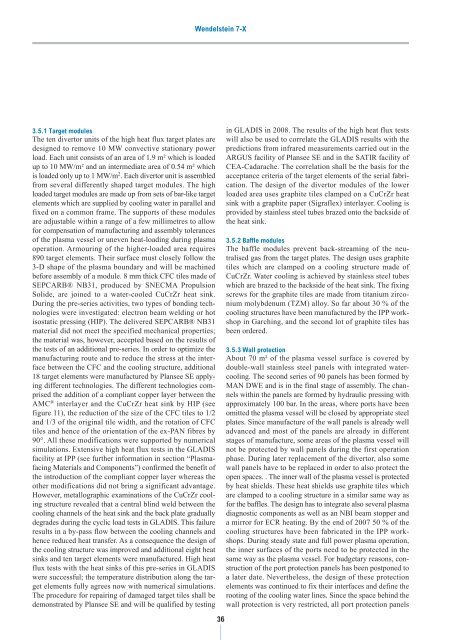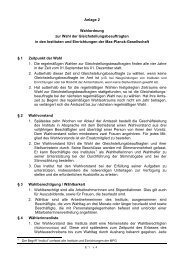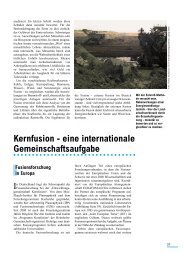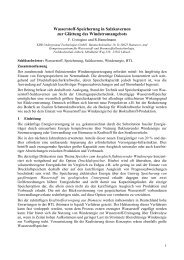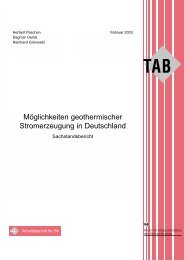IPP Annual Report 2007 - Max-Planck-Institut für Plasmaphysik ...
IPP Annual Report 2007 - Max-Planck-Institut für Plasmaphysik ...
IPP Annual Report 2007 - Max-Planck-Institut für Plasmaphysik ...
You also want an ePaper? Increase the reach of your titles
YUMPU automatically turns print PDFs into web optimized ePapers that Google loves.
3.5.1 Target modules<br />
The ten divertor units of the high heat flux target plates are<br />
designed to remove 10 MW convective stationary power<br />
load. Each unit consists of an area of 1.9 m² which is loaded<br />
up to 10 MW/m² and an intermediate area of 0.54 m² which<br />
is loaded only up to 1 MW/m 2 . Each divertor unit is assembled<br />
from several differently shaped target modules. The high<br />
loaded target modules are made up from sets of bar-like target<br />
elements which are supplied by cooling water in parallel and<br />
fixed on a common frame. The supports of these modules<br />
are adjustable within a range of a few millimetres to allow<br />
for compensation of manufacturing and assembly tolerances<br />
of the plasma vessel or uneven heat-loading during plasma<br />
operation. Armouring of the higher-loaded area requires<br />
890 target elements. Their surface must closely follow the<br />
3-D shape of the plasma boundary and will be machined<br />
before assembly of a module. 8 mm thick CFC tiles made of<br />
SEPCARB® NB31, produced by SNECMA Propulsion<br />
Solide, are joined to a water-cooled CuCrZr heat sink.<br />
During the pre-series activities, two types of bonding technologies<br />
were investigated: electron beam welding or hot<br />
isostatic pressing (HIP). The delivered SEPCARB® NB31<br />
material did not meet the specified mechanical properties;<br />
the material was, however, accepted based on the results of<br />
the tests of an additional pre-series. In order to optimize the<br />
manufacturing route and to reduce the stress at the interface<br />
between the CFC and the cooling structure, additional<br />
18 target elements were manufactured by Plansee SE applying<br />
different technologies. The different technologies comprised<br />
the addition of a compliant copper layer between the<br />
AMC ® interlayer and the CuCrZr heat sink by HIP (see<br />
figure 11), the reduction of the size of the CFC tiles to 1/2<br />
and 1/3 of the original tile width, and the rotation of CFC<br />
tiles and hence of the orientation of the ex-PAN fibres by<br />
90°. All these modifications were supported by numerical<br />
simulations. Extensive high heat flux tests in the GLADIS<br />
facility at <strong>IPP</strong> (see further information in section “Plasmafacing<br />
Materials and Components”) confirmed the benefit of<br />
the introduction of the compliant copper layer whereas the<br />
other modifications did not bring a significant advantage.<br />
However, metallographic examinations of the CuCrZr cooling<br />
structure revealed that a central blind weld between the<br />
cooling channels of the heat sink and the back plate gradually<br />
degrades during the cyclic load tests in GLADIS. This failure<br />
results in a by-pass flow between the cooling channels and<br />
hence reduced heat transfer. As a consequence the design of<br />
the cooling structure was improved and additional eight heat<br />
sinks and ten target elements were manufactured. High heat<br />
flux tests with the heat sinks of this pre-series in GLADIS<br />
were successful; the temperature distribution along the target<br />
elements fully agrees now with numerical simulations.<br />
The procedure for repairing of damaged target tiles shall be<br />
demonstrated by Plansee SE and will be qualified by testing<br />
Wendelstein 7-X<br />
36<br />
in GLADIS in 2008. The results of the high heat flux tests<br />
will also be used to correlate the GLADIS results with the<br />
predictions from infrared measurements carried out in the<br />
ARGUS facility of Plansee SE and in the SATIR facility of<br />
CEA-Cadarache. The correlation shall be the basis for the<br />
acceptance criteria of the target elements of the serial fabrication.<br />
The design of the divertor modules of the lower<br />
loaded area uses graphite tiles clamped on a CuCrZr heat<br />
sink with a graphite paper (Sigraflex) interlayer. Cooling is<br />
provided by stainless steel tubes brazed onto the backside of<br />
the heat sink.<br />
3.5.2 Baffle modules<br />
The baffle modules prevent back-streaming of the neutralised<br />
gas from the target plates. The design uses graphite<br />
tiles which are clamped on a cooling structure made of<br />
CuCrZr. Water cooling is achieved by stainless steel tubes<br />
which are brazed to the backside of the heat sink. The fixing<br />
screws for the graphite tiles are made from titanium zirconium<br />
molybdenum (TZM) alloy. So far about 30 % of the<br />
cooling structures have been manufactured by the <strong>IPP</strong> workshop<br />
in Garching, and the second lot of graphite tiles has<br />
been ordered.<br />
3.5.3 Wall protection<br />
About 70 m² of the plasma vessel surface is covered by<br />
double-wall stainless steel panels with integrated watercooling.<br />
The second series of 90 panels has been formed by<br />
MAN DWE and is in the final stage of assembly. The channels<br />
within the panels are formed by hydraulic pressing with<br />
approximately 100 bar. In the areas, where ports have been<br />
omitted the plasma vessel will be closed by appropriate steel<br />
plates. Since manufacture of the wall panels is already well<br />
advanced and most of the panels are already in different<br />
stages of manufacture, some areas of the plasma vessel will<br />
not be protected by wall panels during the first operation<br />
phase. During later replacement of the divertor, also some<br />
wall panels have to be replaced in order to also protect the<br />
open spaces. . The inner wall of the plasma vessel is protected<br />
by heat shields. These heat shields use graphite tiles which<br />
are clamped to a cooling structure in a similar same way as<br />
for the baffles. The design has to integrate also several plasma<br />
diagnostic components as well as an NBI beam stopper and<br />
a mirror for ECR heating. By the end of <strong>2007</strong> 50 % of the<br />
cooling structures have been fabricated in the <strong>IPP</strong> workshops.<br />
During steady state and full power plasma operation,<br />
the inner surfaces of the ports need to be protected in the<br />
same way as the plasma vessel. For budgetary reasons, construction<br />
of the port protection panels has been postponed to<br />
a later date. Nevertheless, the design of these protection<br />
elements was continued to fix their interfaces and define the<br />
rooting of the cooling water lines. Since the space behind the<br />
wall protection is very restricted, all port protection panels


